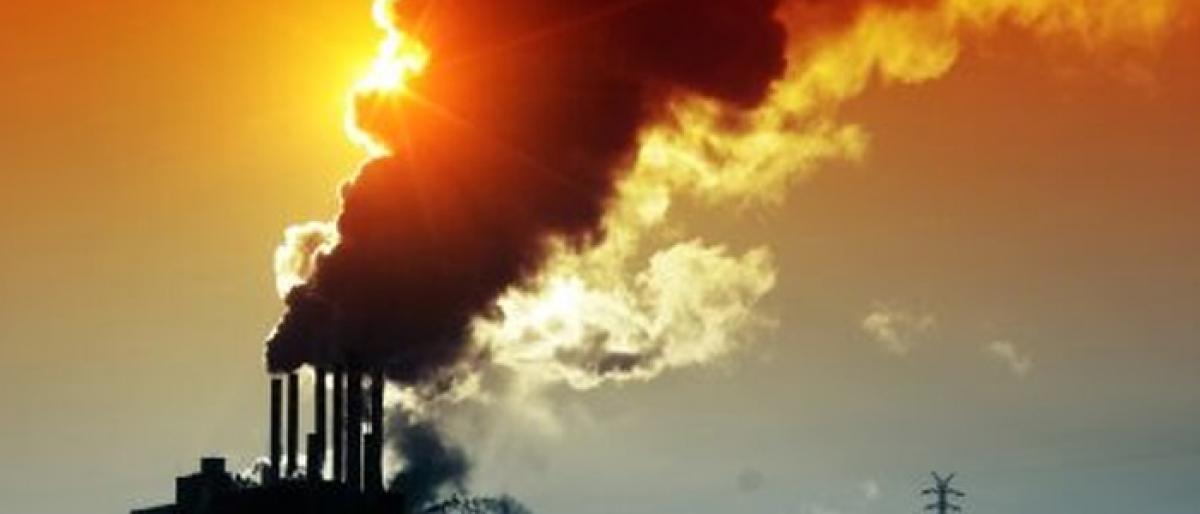Live
- Manchu Vishnu Warns Media Over Family Controversy, Mohan Babu Incident
- Atul Subhash’s Suicide Sparks Outrage; Estranged Wife, Judge Accused of Harassment
- Malaria cases, deaths in India decline by 69pc between 2017-2023: WHO
- ED raids three places in Bengal in online forgery scam case
- Manchu Manoj Questioned by Police Amid Family Dispute
- Bengaluru: IMD Issues Yellow Alert Amid Upcoming Rainfall
- Manchu Vishnu Addresses Media, Clarifies Incident Involving Mohan Babu
- HPCL inks pact with Sea6 Energy to convert seaweed biomass into fuels
- Numaish 2025: Hyderabad’s Grand Exhibition Kicks Off in January – All You Need to Know
- There will be opportunities from every crisis, says CM Chandrababu at collectors' conference
Just In

Here is more evidence why we need to worry about climate change. A new study says extreme rainfall events are on the rise in India and attributes the trend to man-made emissions, what scientists call anthropogenic warming. Not just this, the trend is likely to become more prominent by mid-century, particularly in southern and central India.
New Delhi: Here is more evidence why we need to worry about climate change. A new study says extreme rainfall events are on the rise in India and attributes the trend to man-made emissions, what scientists call anthropogenic warming. Not just this, the trend is likely to become more prominent by mid-century, particularly in southern and central India.
While previous studies have shown a rising trend of extreme rainfall events, this study has sought to link it with anthropogenic emissions. Researchers at the Indian Institute of Technology, Gandhinagar, used historical datasets about daily rainfall and temperature from about 7000 meteorological stations of the India Meteorological Department (IMD), converted it into grids of one-degree spatial resolution.
An analysis of observed changes in yearly maximum rainfall for the period of 1979–2015, showed that it has increased over the majority of India except in the Gangetic Plain, northeastern India, and Jammu and Kashmir. The decline in the Gangetic Plain region can be attributed to a significant reduction in the monsoon season rainfall driven by increased atmospheric aerosols and warming of the Indian Ocean.
The increase in precipitation is more prominent in Southern India than in North India during the 1979–2015. Along with extreme precipitation, the study has found that dew point temperature – temperature at which air gets saturated with moisture – has also increased during the period 1979–2015. With warming, water holding capacity of the atmosphere increases by 6% per degree rise in temperature, per Clausius-Clapeyron equation, the study says.
The scaling relationship between extreme precipitation and dew point temperature shows over 7% increase per unit rise in dew point temperature for the majority of south India. Dew point temperature is a measure of atmospheric humidity, which affects extreme precipitation in the tropical regions. It is considered a better predictor of rainfall extremes than surface air temperature.
In addition to past weather data, researchers used simulations from two sets of models - Coupled Model Inter comparison Project Phase 5 (CMIP5) and Climate of 20th Century Plus (C20C+) – to determine the impact of anthropogenic emissions on extreme rainfall events, under both ‘historic’ and ‘historic natural’ scenarios. This showed that anthropogenic warming leads more extreme rainfall events in India. While ‘historic natural’ scenario includes only natural factors, ‘historic’ included both natural and anthropogenic factors.
“We find that in south and central India, precipitation extremes are more sensitive to warming than north India, which means that south and central India may witness more rainfall extremes in response to climate warming,” explained Dr Vimal Mishra, head of the Water and Climate Lab at IITGn who led the study, while speaking to India Science Wire.
“Rainfall extremes in the 'historic' scenario are higher by 10-30% than the 'historic natural' scenario, indicating the robust impact of anthropogenic warming on the intensity of extreme rainfall,” said Dr Mishra. The frequency of precipitation extremes is projected to rise more prominently in southern and central India in the mid and end of the 21st century under the greenhouse gases concentration trajectory, RCP 8.5 (representative concentration pathway 8.5), which represents the highest emission scenario.
“Since there is a significant impact of climate warming on extreme rainfall over India, we can expect detrimental impacts of these on infrastructure as well as agriculture. This also highlights the need for initiating adaptation and mitigation to avoid the risk and damage due to extreme rain and flooding,” Dr Mishra added.
The research team included Sourav Mukherjee, Saran Aadhar and Viamal Mishra (all from IIT, Gandhinagar) and Daithi Stone (Lawrence Berkeley National Lab). The study has been published in journal Weather and Climate Extremes.
By: Dinesh C Sharma
(India Science Wire)

© 2024 Hyderabad Media House Limited/The Hans India. All rights reserved. Powered by hocalwire.com







